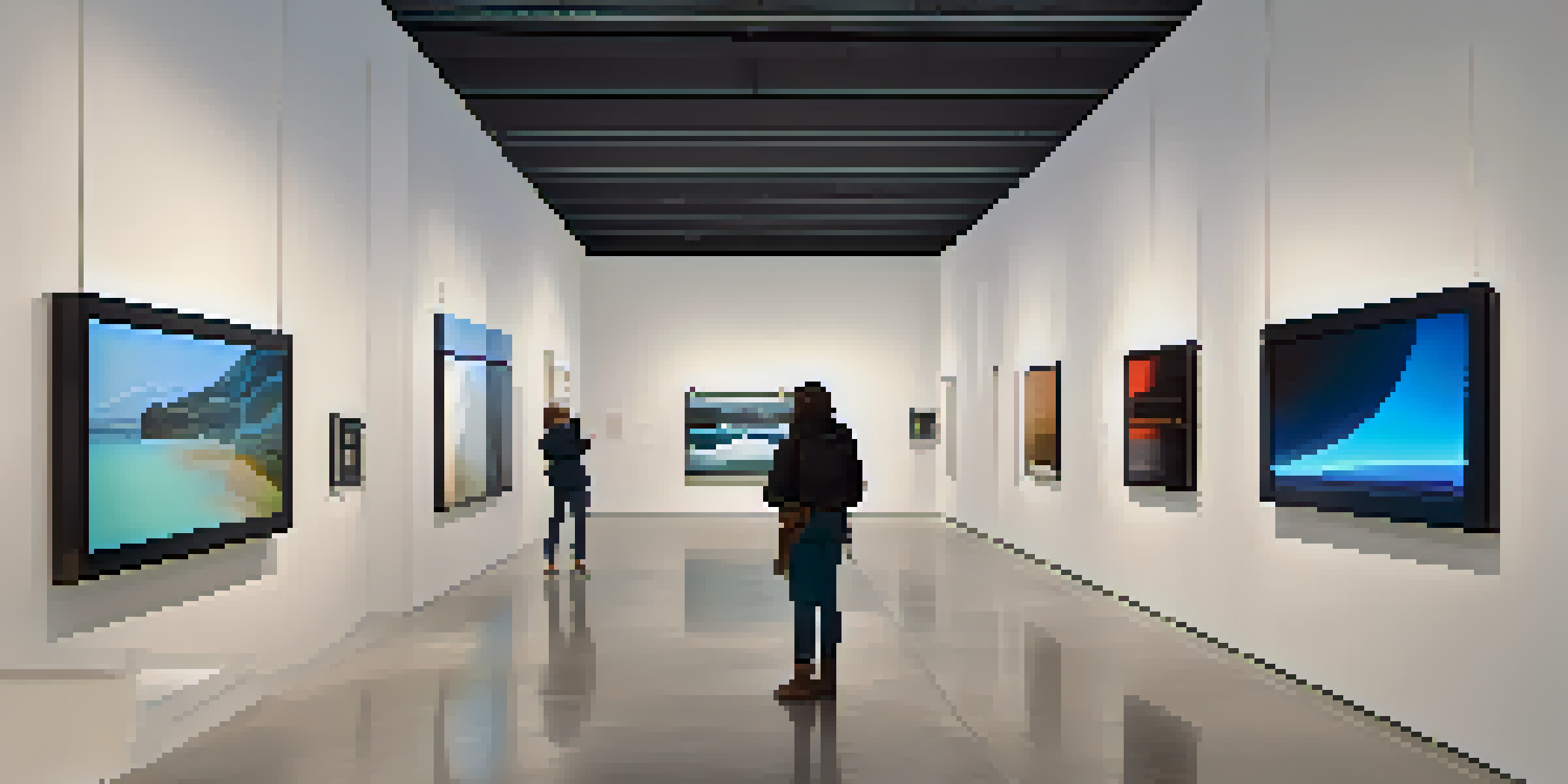The Role of Art Institutions in the Digital Landscape

Understanding the Shift: Art Institutions Embracing Digital
As technology evolves, art institutions are increasingly incorporating digital platforms into their operations. This shift reflects a broader understanding of how audiences engage with art today. Instead of merely hosting physical exhibits, institutions are now curating online experiences that can reach global audiences.
The digital world is a vast canvas, and art institutions must learn to paint on it with creativity and purpose.
For instance, virtual exhibitions allow viewers to explore galleries from the comfort of their homes, breaking down geographical barriers. This transformation not only democratizes access to art but also encourages institutions to innovate in how they present and interpret artistic works.
The rise of social media further amplifies this shift, allowing institutions to share their collections and events in real-time. By leveraging these tools, they can foster a community of art lovers who feel connected, regardless of where they are in the world.
Engaging Audiences: The Role of Interactive Experiences
Art institutions are harnessing interactive technologies to deepen audience engagement. This includes virtual reality (VR) experiences that allow visitors to step inside artworks or augmented reality (AR) applications that bring art to life through their smartphones. Such immersive experiences can transform how people perceive and appreciate art.

Consider the example of a museum that offers a VR tour of a famous painting, allowing viewers to explore its details up close. This hands-on approach not only captivates audiences but also fosters a more profound understanding of the artist's intent and technique.
Digital Platforms Enhance Art Access
Art institutions are leveraging digital platforms to create online experiences that democratize access to art and engage global audiences.
By creating opportunities for interaction, art institutions can cater to diverse audiences, including younger generations who are accustomed to engaging with content in dynamic ways. This adaptability is crucial for maintaining relevance in the fast-paced digital landscape.
Building Community: Online Platforms and Collaboration
Digital platforms have become essential for art institutions to build and nurture communities. From online forums to social media groups, these spaces allow art enthusiasts to connect, share, and discuss their passions. Institutions can also use these platforms to solicit feedback and encourage dialogue around their exhibits.
Art is not what you see, but what you make others see. In the digital age, this vision can reach a global audience.
For example, an art institution might host a live Q&A session with an artist on Instagram, giving followers an opportunity to engage directly. This not only humanizes the institution but also creates a sense of belonging among participants.
By fostering collaboration, art institutions can tap into the creativity of their audience, leading to co-created projects that reflect community interests. This participatory approach enhances the institution's role as a hub for artistic expression and discourse.
The Challenge of Curation in a Digital World
Curating art in the digital age presents unique challenges for institutions. With an overwhelming amount of content available online, distinguishing quality works and providing meaningful context becomes vital. Institutions must adopt a thoughtful approach to curation that resonates with their mission while appealing to diverse audiences.
For instance, a digital exhibit might focus on underrepresented artists, shedding light on voices that often go unnoticed. By curating with intention, institutions can drive important conversations and broaden the narrative around art history.
Interactive Tech Boosts Engagement
By incorporating interactive technologies like VR and AR, art institutions deepen audience engagement and enhance the appreciation of artistic works.
Moreover, the digital landscape allows for more flexible curation methods. Institutions can experiment with themes, formats, and collaborations that reflect current trends, ensuring their offerings remain fresh and relevant.
Data-Driven Insights: Analytics in Art Institutions
The integration of analytics into art institutions' strategies is revolutionizing how they understand their audiences. By tracking engagement metrics and user behavior, institutions can gain valuable insights into what resonates most with their visitors. This data-driven approach helps them tailor their offerings and marketing strategies effectively.
For example, an institution might discover that its audience is particularly interested in contemporary art, leading to a strategic focus on that genre in future exhibitions. This not only enhances visitor satisfaction but also strengthens the institution's relevance in the cultural landscape.
Additionally, data can guide decisions on outreach efforts, helping institutions identify underserved communities and tailor programs to foster inclusivity. Understanding audience demographics allows institutions to create targeted initiatives that encourage broader participation.
Preserving Art in the Digital Age: Challenges and Solutions
As art institutions embrace digital formats, the challenge of preservation comes to the forefront. Digital works can be ephemeral, and ensuring their longevity requires careful planning and investment in technology. Institutions must develop strategies to archive and maintain digital art effectively, safeguarding it for future generations.
For instance, an institution might implement a robust digital preservation system to store and protect its online collections. This ensures that even as technology evolves, the institution can continue to showcase its works without loss of quality or accessibility.
Data Analytics Inform Art Strategies
The use of analytics allows art institutions to understand audience preferences better, tailoring exhibitions and programs to foster inclusivity and relevance.
Moreover, educating staff and audiences about the importance of digital preservation is crucial. By fostering a culture of awareness, art institutions can ensure that digital art remains a vital part of our cultural heritage.
The Future: Art Institutions and Digital Innovation
Looking ahead, the future of art institutions will undoubtedly be shaped by digital innovation. As technologies advance, institutions must remain agile and open to change, continually exploring new ways to engage and educate their audiences. This could include everything from AI-driven art recommendations to blockchain for provenance tracking.
For example, imagine an art institution using AI to curate personalized experiences for visitors, suggesting works based on their preferences. This level of customization can significantly enhance visitor engagement and satisfaction.

Ultimately, by embracing digital innovation, art institutions can not only survive but thrive in an ever-evolving landscape. Their adaptability will be key to fostering a vibrant art community that reflects the diverse voices and stories of our time.